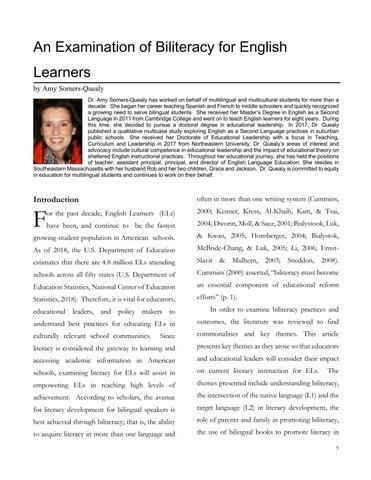!"#$%&'("&)(*"#*+#,(-()./&01#+*/#$"2-(34# 5.&/"./3! by Amy Somers-Quealy Dr. Amy Somers-Quealy has worked on behalf of multilingual and multicultural students for more than a decade. She began her career teaching Spanish and French to middle schoolers and quickly recognized a growing need to serve bilingual students. She received her Master’s Degree in English as a Second Language in 2011 from Cambridge College and went on to teach English learners for eight years. During this time, she decided to pursue a doctoral degree in educational leadership. In 2017, Dr. Quealy published a qualitative multicase study exploring English as a Second Language practices in suburban public schools. She received her Doctorate of Educational Leadership with a focus in Teaching, Curriculum and Leadership in 2017 from Northeastern University. Dr. Quealy’s areas of interest and advocacy include cultural competence in educational leadership and the impact of educational theory on sheltered English instructional practices. Throughout her educational journey, she has held the positions of teacher, assistant principal, principal, and director of English Language Education. She resides in Southeastern Massachusetts with her husband Rob and her two children, Grace and Jackson. Dr. Quealy is committed to equity in education for multilingual students and continues to work on their behalf.
Introduction
often in more than one writing system (Cummins,
or the past decade, English Learners (ELs)
F
2000; Kenner, Kress, Al-Khaib, Kam, & Tsai,
have been, and continue to be the fastest
2004; Dworin, Moll, & Saez, 2001; Bialystook, Luk,
growing student population in American schools.
& Kwan, 2005; Hornberger, 2004; Bialystok,
As of 2018, the U.S. Department of Education
McBride-Chang, & Luk, 2005; Li, 2006; Ernst-
estimates that there are 4.8 million ELs attending
Slavit &
schools across all fifty states (U.S. Department of
Cummins (2000) asserted, “biliteracy must become
Education Statistics, National Center of Education
an essential component of educational reform
Statistics, 2018). Therefore, it is vital for educators,
efforts” (p. 1).
Mulhern,
2003;
Sneddon,
2008).
educational leaders, and policy makers to
In order to examine biliteracy practices and
understand best practices for educating ELs in
outcomes, the literature was reviewed to find
culturally relevant school communities.
Since
commonalities and key themes. This article
literacy is considered the gateway to learning and
presents key themes as they arose so that educators
accessing academic information in American
and educational leaders will consider their impact
schools, examining literacy for ELs will assist in
on current literacy instruction for ELs.
empowering ELs in reaching high levels of
themes presented include understanding biliteracy,
achievement. According to scholars, the avenue
the intersection of the native language (L1) and the
for literacy development for bilingual speakers is
target language (L2) in literacy development, the
best achieved through biliteracy; that is, the ability
role of parents and family in promoting biliteracy,
to acquire literacy in more than one language and
the use of bilingual books to promote literacy in
The
5





